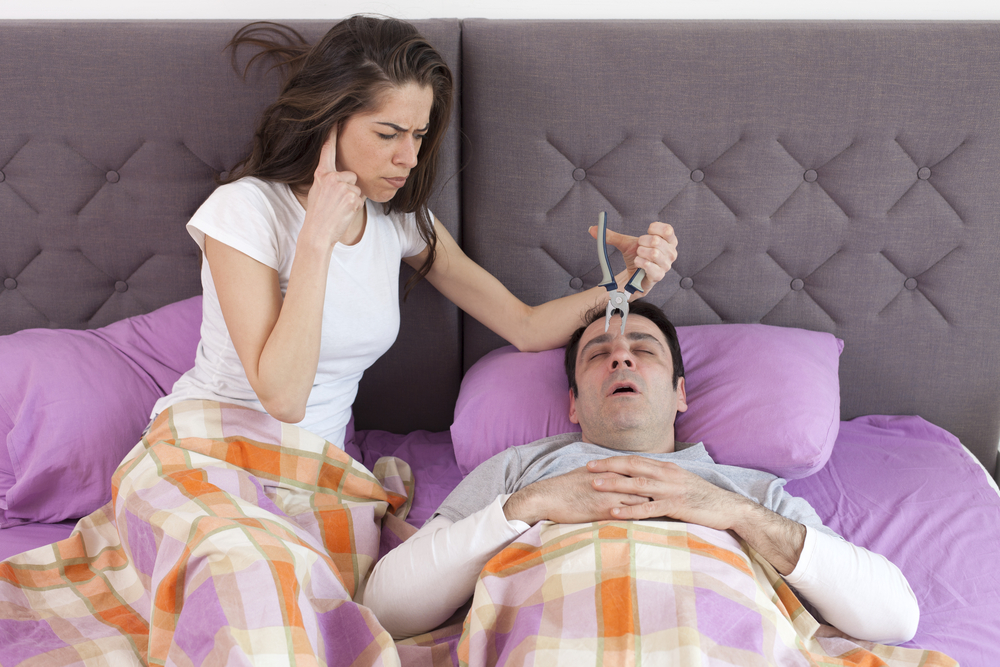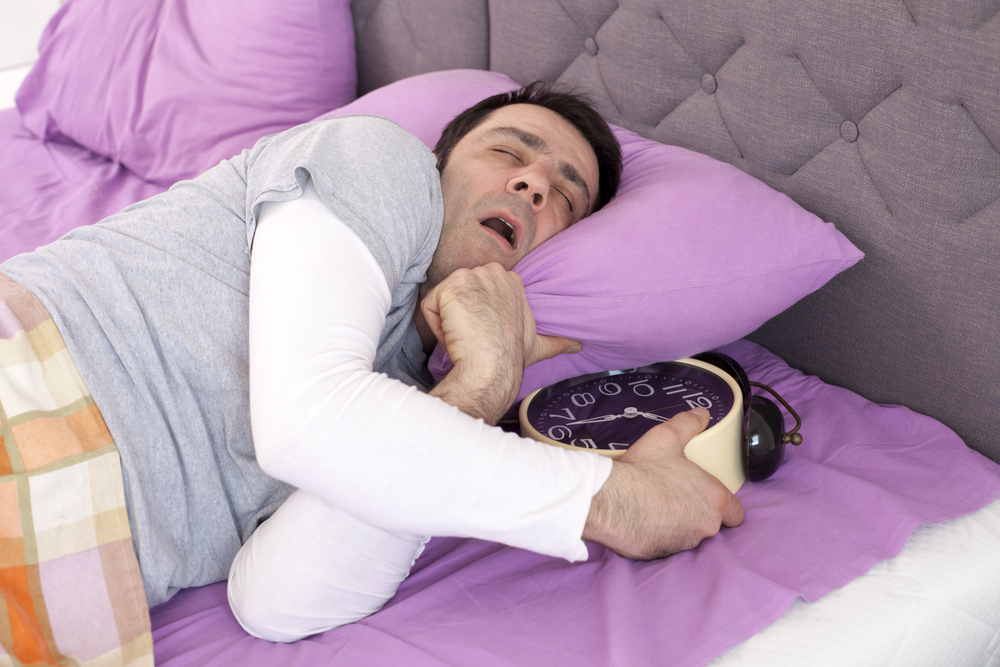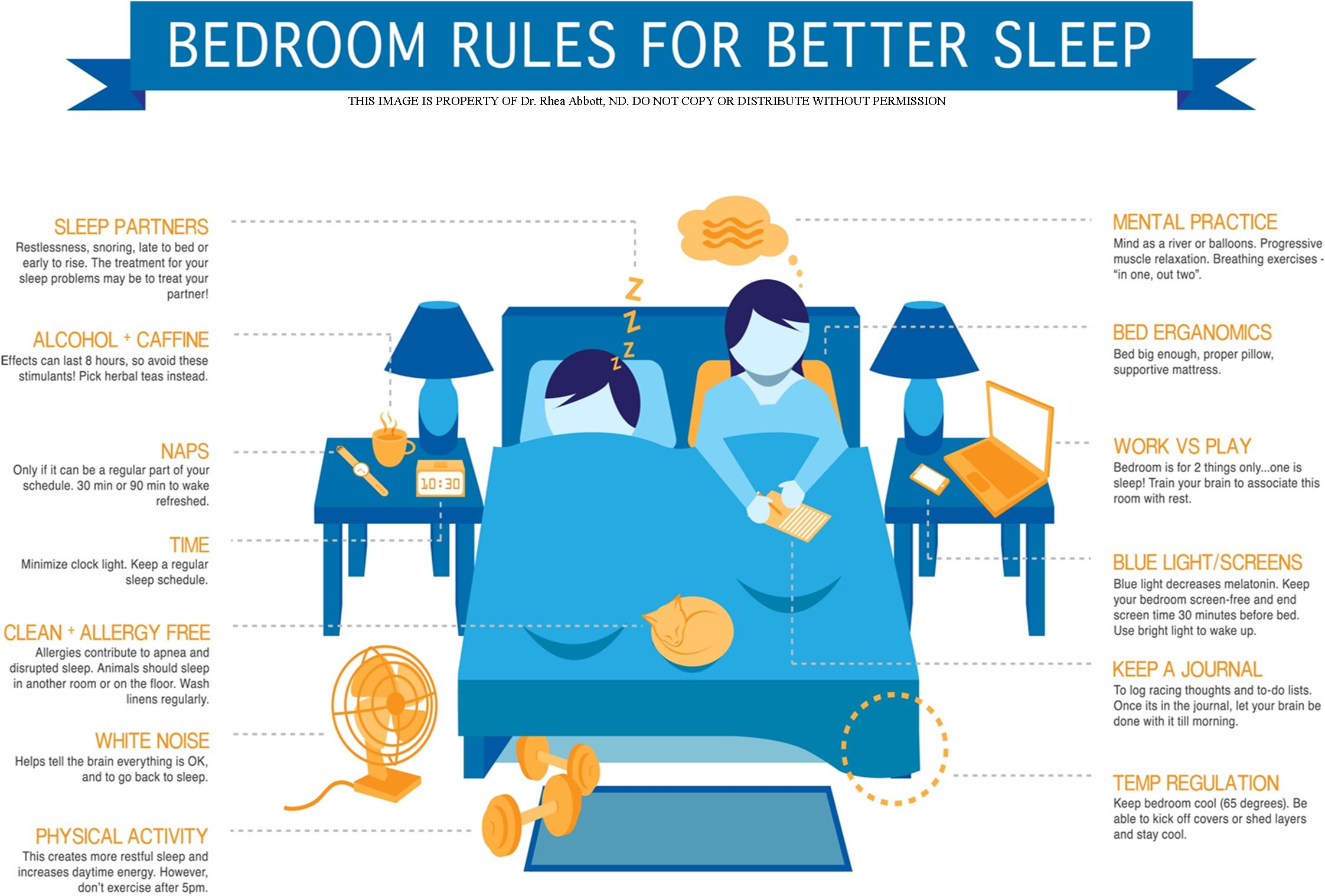By Dr. Rhea Abbott, ND
As a sleep specialist, I’ve noticed we often turn to pills (whether natural or pharmaceutical) as solutions to our sleep troubles, while totally overlooking the basics – your bedroom! Our sleep environment is full of subliminal cues and you can make a big impact on your sleep just by the way you interact with your bedroom or conduct your nighttime routine. Read on for in-depth discussion of how each of these Bedroom Rules plays a role in the restfulness of your nights!
 SLEEP PARTNERS: Maybe your restless sleep isn’t about you! I get at least one patient a month whose most important treatment for their sleep problem is…to treat their bed partner! Is your bedmate restless? Do they snore like a bear? Do they come to bed later than you, or get up much earlier? Do they watch TV in bed while you’re trying to sleep? Do they get up in the night because of night sweats and have to change the sheets? Maybe “lights out” is the first opportunity for intimacy after a long day and they’re interested in a different meaning of the word “sleeping together”.
SLEEP PARTNERS: Maybe your restless sleep isn’t about you! I get at least one patient a month whose most important treatment for their sleep problem is…to treat their bed partner! Is your bedmate restless? Do they snore like a bear? Do they come to bed later than you, or get up much earlier? Do they watch TV in bed while you’re trying to sleep? Do they get up in the night because of night sweats and have to change the sheets? Maybe “lights out” is the first opportunity for intimacy after a long day and they’re interested in a different meaning of the word “sleeping together”.
ALCOHOL: I’ve had plenty of patients tell me that a glass of wine with dinner or before bed helps them fall asleep, but then they wake up in the night. Though it is sedating at first, it becomes a stimulant as it gets metabolized. Women are more likely to report sedative effects of alcohol and men are more likely to report stimulating effects. Considering there are lots of other ways to relax before bed that don’t carry stimulating side effects, I suggest you trade in the glass of Merlot for a deck of cards or a nice cup of Sleepytime tea.
CAFFEINE: Caffeine is a well-known stimulant. On average, its effects can last more than six hours but our tolerance for it can vary widely. Avoid caffeine in the 6-7 hours before you’d like to be asleep. Be aware: the effects of caffeine are cumulative. One serving of coffee is considered to be 6 oz, but a Starbucks “grande” is 16 oz! So if you’re tanking up on a grande to get you through that afternoon slump, you’re actually getting 2 ½ servings of caffeine and it will be affecting you longer than the typical 6 hours. Studies have shown it takes as little as 100mg of caffeine to get the benefits (that grande has 330mg), so you may find you don’t actually need a big volume to get the pick-me-up.
NAPS: Do you find naps make you feel groggy? Our natural sleep rhythms have a 90-minute cycle. If we interrupt this cycle at our point of deepest sleep, we come out of it with that foggy feeling. To wake refreshed, either limit yourself to 20 minutes (wake before you reach deep sleep) or allow yourself the full 90 minutes (wake after completing a full cycle). Naps under special circumstances (pulled an all-nighter, must nap to drive safely, etc) can be harmless, but random naps here and there reduce our brain’s drive for sleep that night. I tell people not to nap unless (1) they absolutely have to or (2) they can make it a regular part of their routine. I personally found that cutting out naps cured my nighttime waking problem!
 CLOCK: You shouldn’t be able to see your clock if you wake in the night. This means either turning a digitally-lit clock to face the wall, using an analog clock, or using a digital clock that only lights up if you press a button. The last thing you need in the middle of the night are red glowing numbers staring at you, reminding you of how little time you have left to sleep. Don’t ruminate on what time it is. Worrying about getting to sleep is a sure-fire way to delay it!
CLOCK: You shouldn’t be able to see your clock if you wake in the night. This means either turning a digitally-lit clock to face the wall, using an analog clock, or using a digital clock that only lights up if you press a button. The last thing you need in the middle of the night are red glowing numbers staring at you, reminding you of how little time you have left to sleep. Don’t ruminate on what time it is. Worrying about getting to sleep is a sure-fire way to delay it!
TIME: One of the best ways to help ourselves get sleepy at the right time in the evening is to anchor our wake time. This means getting up at roughly the same time every morning – even weekends. I know it sounds like a sin to avoid sleeping in on the weekends, but snoozing until 10am on Sunday morning makes it that much harder to go to sleep at a reasonable time Sunday night…and then you’re in for a rough Monday, right? Your entire week of wake times should be within an hour of each other. Consistency is key!
CLEAN AND ALLERGY-FREE: The bedroom should be a calm, boring place, so keep things tidy. Messy rooms are visually chaotic and suggest unfinished chores (not the most calming thought). Animals are rarely sound sleepers, so having them in the bedroom can be a big disruption (hamsters running on their wheels, the dog that can’t get comfortable or snores, the cat that wants to be let out..and then back in…and then back out…). If you wake with congestion, you may have a dust mite allergy. Pillows, stuffed animals, and down comforters are where dust mites love to congregate! Put these items in the dryer on high for 20 minutes every week to kill/remove dust mites. Consider investing in dust mite covers for pillows and mattresses.
WHITE NOISE: Use a fan to keep cool and to provide white noise. This is great for parents who feel like their brain is always listening for the kids and never quite goes all the way to sleep. It will drown out the innocent little noises we don’t really need to wake up for. A room that is too quiet can also disrupt sleep. Back in the day when we slept outside, the sounds of our pack animals, of our campfire, of the wind in the trees…these were all normal sounds that told our brain everything was OK. Silence would have been very suspicious and might suggest a predator was around! White noise gives our brain something benign to listen to.
PHYSICAL ACTIVITY: Exercise is a great way to prepare the body for sleep. It burns excess energy, increases daytime energy, and releases endorphins which create feelings of calm comfort. Just remember to do your exercise outside the bedroom, and wrap up no later than 5pm (since it can, at first, be stimulating).
MENTAL PRACTICES: For the mind that seems to race with random active thoughts, try mental practices to bring attention to your body and quiet the crowds in your head!
- “Mind as a River”: Imagine your mind as a gently flowing river. All your thoughts are like leaves floating on the surface of the water. Allow the thoughts to come, rather than fighting them. Then see them leave effortlessly as the river pushes them along. Visualize the number of leaves becoming fewer and fewer. If some leaves get stuck (recurring thoughts), make the river get stronger to wash them away, then bring it back to a calm flow.
- “Mind as Balloons”: Similar to the river, your thoughts are balloons. Let them exist, observe their color, then let them go and float away until they cannot be seen any longer.
- Progressive muscle relaxation (PMR): Starting with your toes, contract the muscles tight for 5 seconds, then relax. Move to your ankles. Then calves. Continue moving up the body, squeezing the muscles without moving the limbs. Your body should feel heavy and relaxed by the time you get to your head.
- “One-in, two-out”: This is a breath counting method. Inhale, count “one”. Exhale, count “two”. Inhale, count “three”, exhale, count “four”. If a thought intrudes or you get distracted, just start again at “one”. There is no goal, just keep counting as high as you can until you find yourself falling asleep.
- 4-7-8 Breathing: Inhale quietly through your nose for the count of 4. Hold your breath for the count of 7. Exhale in a “shoo” for a count of 8. People often report this making them feel sleepy in as little as 5 minutes!
BED ERGONOMICS: Is your bed big enough for you and your partner? Is your mattress supportive for your back and hips? If your mattress is more than 10 years old, you have your doctor’s permission to buy a new one! Different pillows are best for different types of sleepers. Thin flat pillows are best for tummy sleepers, fluffy pillows for back sleepers, and “cervical pillows” with a wave profile for side sleepers. Add pillows under or between your knees to align your spine and hips.
WORK/PLAY vs SLEEP: The bedroom is for two things only…and one of them is sleep! Work, TV, reading, browsing the internet, tough conversations about bills or dinner plans – all of this should happen outside the bedroom. Even your wind-down routine should be taking place elsewhere. Train your brain to associate your bed with sleepiness ONLY, not with problem solving or active thinking.
 SCREENS: Screens of all kinds (TV, ipad, phone, computer, smart watches) emit a frequency of blue light that passes through our retinas and turns off the organ that makes melatonin. Keep screens/phones out of the bedroom and avoid using them for at least 30 minutes before bed time. A widget called “f.lux” removes blue light from your screens when the sun goes down in your area. On the other hand, full spectrum light (daylight) can be useful for turning off our melatonin in the morning when we need to be alert, so throwing open the curtains or eating breakfast next to the window will help you wake up!
SCREENS: Screens of all kinds (TV, ipad, phone, computer, smart watches) emit a frequency of blue light that passes through our retinas and turns off the organ that makes melatonin. Keep screens/phones out of the bedroom and avoid using them for at least 30 minutes before bed time. A widget called “f.lux” removes blue light from your screens when the sun goes down in your area. On the other hand, full spectrum light (daylight) can be useful for turning off our melatonin in the morning when we need to be alert, so throwing open the curtains or eating breakfast next to the window will help you wake up!
KEEP A BEDSIDE NOTEBOOK: For the mind that is racing with worries and to-dos, keep a notebook next to the bed. Each night before you turn in, jot down a bullet list of the thoughts that are distracting you. Write down your to-do list so you won’t be running though it in your head. This is a way of physically removing the thoughts from your mind and putting them on paper. Then close the book and put it away on a shelf or in a drawer. You are literally putting your thoughts away for the night. Tell yourself, “I already thought about this today, and I can think about it again tomorrow. Now is my time to rest”. You can use this technique again when you wake in the middle of the night and the thoughts pounce!
TEMPURATURE REGULATION: As we sleep, our core body temperature lowers. It reaches its lowest point about 4 hours before we wake and this promotes our deepest sleep. If we’re too warm, we miss out on this cue and may wake in the night. Dress in layers that can be easily shed if you become too warm. Keep the sheets by your feet untucked so you can throw them off or stick your feet out to cool down. Lower your thermostat at night to keep your bedroom about 65 degrees Fahrenheit. If you’re using a fan for white noise, point it at the foot of the bed to cool hot feet.
Fascinating stuff, right? When patients come to me with sleep problems, I always start with this. Yes, it’s easy to reach for melatonin or to hope that Trazadone is going to knock you out. But consider that no amount of melatonin is going to counteract your dust mite allergy, and no dose of Trazadone is going to treat your partner’s sleep apnea.
There are dozens of factors that affect our sleep, and each person has a different combination of them. From hormonal imbalance to low blood sugar, high cortisol to depression – there are lots of internal elements that could be interfering with your sleep. There are certainly people who need help from supplements or prescriptions to get their best rest. But there are also lots of people who don’t need all that. If you’re one of these lucky people, why would you want to rely on pills when the solution could be as easy as making these (free!) changes?
So how can you use this information to get more restful sleep? Print out this graphic, walk into your bedroom, and make some changes right now that will improve your sleep TONIGHT.

